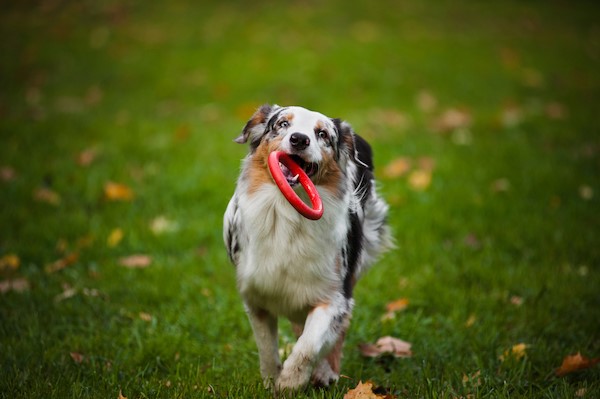Australian Shepherd Weight and Growth Chart
Posted: 11/09/2023 | BY: Humberto Noguera | Categories: Dog , Dog Weight and Growth Chart
The Australian Shepherd is a popular, high-energy dog. They’re known for their active lifestyle and hard-working nature; they are often used as service dogs and therapy dogs. This intelligent, hard-working dog was developed as a ranching companion for cowboys. These “Aussies” have nothing to do with Australia, and their origins are actually rooted in Europe. California ranchers recognized the Australian Shepherd’s endless energy levels as a plus to ranchers on horseback, and the breed was then perfected in America. Aussies are also used during rodeos or on farms where Australian Shepherds excel at being expert herding dogs. The Australian Shepherd serves as an excellent rescue dog and shines in competitive dog sports outside the ranch.
Now that you have an energetic, fuzzy, lovable Aussie puppy, you may be wondering how big will my Australian Shepherd puppy grow? When do Australian Shepherds stop growing? When are Australian Shepherds fully grown? What is the average weight of an Australian Shepherd? Australian Shepherds are a medium-sized breed with very consistent growth. This means that their healthy growth, male weight, and female weight can be more easily predicted. This makes it easier for people who want specific measurements or qualities in a dog they’re looking to adopt.
To help you understand what to expect as your puppy grows up, we’ve created Australian Shepherd growth charts you can use to keep track of your pup’s growth patterns. These charts provide a good representation of the typical growth rates for each month toward adulthood. Our guides can also give Australian Shepherd pet parents an idea of how much space these energetic dogs need based on the current size. Dog owners can plan for appropriate places for their puppy to burn off that energy.

Australian Shepherd Puppy Growth Patterns: How Much Should an Aussie Weigh?
Keep an eye on your Australian Shepherd pup’s growth by tracking their height and weight every month. If they’re not meeting statistical averages, something could be off with the diet or genetics of that particular dog breed. However, there is more stability in how Australian Shepherd pups grow than in other breeds, like German Shepherds, who can experience rapid increases in stature due to growth spurts.
Make sure you discuss any sudden changes observed when getting veterinary care for them, so it doesn’t become a problem later down the line. If your Australian Shepherd loses weight or you have an overweight Australian Shepherd, vet advice is necessary to put your pup back on a path of health.
When it comes to finding the perfect diet for your Australian Shepherd, you’ll want a nutritional balance essential in maintaining their health and longevity. Because of this breed’s active lifestyle, pup parents must carefully select dog food best suited to their canine’s needs.
Your Australian Shepherd puppy is a growing animal, and you must take her to see the vet at 6 and 12 months old. A regular checkup will make sure any potential growth issues are diagnosed to prevent stunted or accelerated growth. The office will also provide veterinary advice on puppy food, proper diet, and balanced diet choices, which helps with a puppy’s weight and growth management down the road.
The Australian Shepherd is a medium-sized dog that takes up to 16 months for full growth. The height of this breed should be settled at 12 months of age. By then, your puppy should weigh between 30 – 45 pounds, depending on its gender. Use the estimates in our Australian Shepherd weight chart by age to keep track of your puppy’s birth weight and growth over the next year.
It’s important for Aussie Shepherd parents to know the kinds of health issues their pup may be prone to. Equally important is being able to afford veterinary care should your fur baby become seriously ill or injured. That’s why more and more pup parents are enrolling their dogs into a pet insurance plan.
Male Australian Shepherd Growth Chart from Puppy to Adult
The male Australian Shepherd grows taller and is heavier than his female counterparts. Remember, Australian Shepherds are not large dogs, and the ideal weight of the male dog varies depending on their age.
The average weight for male Australian Shepherds at 12 months of age is between 43 – 60 pounds and 18 to 23 inches tall. The growth chart below shows what you can expect as your male Aussie grows up, going from puppy size all the way to adult weight:
| Age | Weight |
| 1 month | 8 pounds |
| 2 months | >15 pounds |
| 3 months | 25 pounds |
| 4 months | 30 – 32 pounds |
| 5 months | 30 – 40 pounds |
| 6 months | 45 pounds |
| 7 months | 49 – 50 pounds |
| 8 months | 53 pounds |
| 9 months | 56 pounds |
| 10 months | 58 pounds |
| 11 months | 59 pounds |
| 12 months/1 year | 60 pounds |
| 16 months | 64 – 65 pounds |

Female Australian Shepherd Growth Chart from Puppy to Adult
Female Australian Shepherds are known for their intelligence and loyalty. They typically weigh between 18-21 inches tall with a smaller frame that tops out at 65 pounds when they become an adult Australian Shepherd. As female Australian Shepherd puppies grow, it’s not uncommon for them to not be fully developed until 16 months old.
What happens if your Australian Shepherd becomes pregnant as an adult?
The Australian Shepherd’s pregnant body undergoes a series of changes to prepare for birth. The female Australian Shepherd’s weight may increase by 15-20%. At the same time, she builds the strength and tissue necessary to safely deliver her puppies. Don’t breed your female Australian Shepherd before sexual maturity because this can lead to severe health complications.
The female average Australian Shepherd weight chart below displays the healthy weight patterns for a female Aussie:
| Age | Weight |
| 1 month | 6 pounds |
| 2 months | 14 pounds |
| 3 months | 18 – 20 pounds |
| 4 months | 23 pounds |
| 5 months | 27 pounds |
| 6 months | 33 pounds |
| 7 months | 36 pounds |
| 8 months | 38 pounds |
| 9 months | 40 pounds |
| 10 months | 42 pounds |
| 11 months | 43 pounds |
| 12 months/1 year | 44 – 45 pounds |
| 16 months | 45 pounds |
When is an Australian Shepherd Full Grown?
Like other medium-sized breeds, the Australian Shepherd grows until they reach their full height and weight. This process typically occurs between 12 – 18 months or when the dogs are 1 to 1.5 years old. However, there’s some variation due to genetic factors and environmental ones like diet or exercise level, which can affect how fast each dog grows during this period.
Your Australian Shepherd is a hard-working and friendly pup who will grow into an energetic, loyal companion. As an Aussie owner, you can expect that there will be some changes in size during the first year of your dog’s life as they develop. Use our weight charts to watch over your Australian Shepherd pup while she grows up.

Is Your Australian Shepherd Healthy?
The Australian Shepherd is a beautiful, friendly dog who will steal your heart. Unfortunately, this breed is more susceptible to genetic diseases, which can compromise the quality of life. Adult Aussies’ disorders are often treatable or preventable through regular vet care. Getting preventive medical treatment and a pet insurance policy gives you an ideal combo to ensure your puppy has long, happy years ahead of her. Here are some common health conditions that affect Australian Shepherds:
Eye diseases and defects
Cataracts
Australian Shepherds are prone to cataracts, a potentially debilitating condition wherein the lens becomes cloudy in one or both eyes. It can lead to impaired vision and blindness if not treated immediately. The dog’s symptoms typically appear when they’re between 1-3 years old but may occur as late as 7 years old.
Collie Eye Defect
Collie eye anomaly is a condition that affects Collies and Australian Shepherds. It can lead to retinal detachment and blindness. The only way of preventing this condition is through surgery. Still, it cannot reverse any damage done by the mutation already in process.
Coloboma
Coloboma is a condition that affects the irises in Australian Shepherd dogs. The part of an eye where black pigment is does not develop, so you can see through to your puppy’s white sclera (the area surrounding their dark-colored eyes). This lack of coverage causes discomfort when they’re exposed to bright lights. Coloboma affects merle-colored Australian Shepherds most and typically appears at birth.

Hip and Elbow Dysplasia
Hip dysplasia is a condition that can affect dogs, causing the thigh bone to fit improperly into the hip socket. Over time, the socket will wear down, causing lameness, pain, and general discomfort. The condition can range from mild to severe, with the latter requiring complete surgical replacement.
Elbow dysplasia is a condition that causes lameness and pain in dogs. It occurs when the elbow joint doesn’t fit properly into the elbow socket. It can affect both young and old dogs, but they may not show any signs until they are older or have been resting for some time after exercising.
Hypothyroidism
Hypothyroidism is a condition that occurs when the dog’s thyroid gland doesn’t produce enough hormones, so their metabolism isn’t maintained. This leads to symptoms like weight gain and sluggishness in movement; it can be treated with medication or surgery.
Cancer
Hemangiosarcoma
Hemangiosarcoma is a type of cancer that can grow as a tumor in the spleen, liver, or heart. Unfortunately, this cancer might not be evident until the dog collapses unexpectedly. Diagnosis is made via X-rays, biopsy, or ultrasound. Cancer can be treated but not cured.
Lymphoma
Lymphoma occurs in the lymph nodes, spleen, or bone marrow. One common sign to look out for in your dog would be enlarged lymph nodes behind the knee or under the jawline. There is no cure; thus, chemotherapy and radiation treatments control cancer spread.
Multi-Drug Sensitivity
Unfortunately, multi-drug sensitivity is relatively common among Australian Shepherds. This means that even something as minor and straightforward as flea medication could potentially put your Aussie at risk for any number of problems. The brain can’t correctly process medication information because it’s constantly being blocked by MDR1. This situation leads to severe physical disabilities and even death in some cases.

Protect your Australian Shepherd puppy with pet insurance.
Pet insurance is a must-have for any Australian Shepherd owner. You can’t control Australian Shepherd genetics, and health problems may occur over your dog’s lifetime. What if your Australian Shepherd pup develops cancer or eye problems? The veterinary costs can add up quickly without proper coverage, but with a pet health care plan, up to 90% of those costs are reimbursed to you. Get peace of mind knowing that you’ve got it covered and avoid expensive complications down the road by getting a quote for your Australian Shepherd today.
Disclaimer
The information contained on this blog is intended for informational and educational purposes only and should not be construed as medical advice. It is not a substitute for professional veterinary care. Always consult with your veterinarian before making any changes to your pet's health care or treatment plan.
The authors of this blog are not veterinarians and do not claim to be experts in pet health. The information provided here is based on our own experiences and research, as well as information from reputable sources. However, we cannot guarantee the accuracy or completeness of this information.
We encourage you to do your own research and consult with your veterinarian before making any decisions about your pet's health.
Compare top pet insurance providers plans.
Enter your dog’s age in years and months to calculate their age equivalent to human years.
Calculate your dog’s ageEnter your cat’s age in years and months to calculate their age equivalent to human years.
Calculate your cat’s age